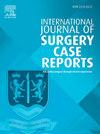Delayed minimally invasive treatment of an infected mandibular angle fracture after wisdom tooth removal: A case report with 2 years follow up
IF 0.6
Q4 SURGERY
引用次数: 0
Abstract
Introduction
This case report describes the treatment of an infected mandibular angle fracture 50 days after wisdom tooth removal.
Case presentation
A 57-year-old woman with a history of mandibular right wisdom tooth extraction 50 days earlier presented to our clinic with restricted mouth opening, significant pain, paresthesia in her right chin, and fever (temperature, 38.5 °C). Intraoral examination revealed malocclusion and an open purulent laceration of the soft tissue in the 48 region. Orthopantomography and computed tomography revealed a displaced fracture of the right mandibular angle and bone loss secondary to infection.
Three-phase treatment comprising wound debridement, open reduction internal fixation, mandibulomaxillary fixation, and reconstruction using autologous iliac bone graft resulted in successful osseous healing. Satisfactory centric occlusion and jaw opening within the normal range with no mandibular deviation were achieved.
Clinical discussion
Wisdom tooth extraction is a common oral and maxillofacial procedure, of which mandibular fracture is an uncommon complication. Iatrogenic mandibular fractures are extremely rare, with an incidence of 0.005 %. Treatment involving debridement of the infected site and rigid internal fixation via an intraoral approach can reduce the incidence of facial nerve injury and scarring.
Conclusion
Impacted wisdom teeth must be extracted after careful consideration and using appropriate techniques. Complications such as mandibular fractures warrant early treatment in a specialist clinic to minimize further complications.
求助全文
约1分钟内获得全文
求助全文
来源期刊
CiteScore
1.10
自引率
0.00%
发文量
1116
审稿时长
46 days

 求助内容:
求助内容: 应助结果提醒方式:
应助结果提醒方式:


